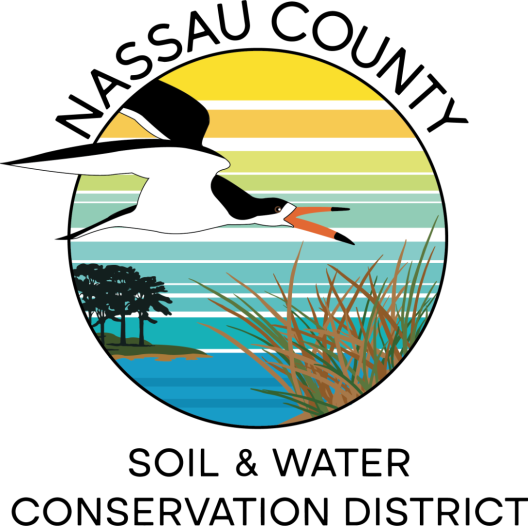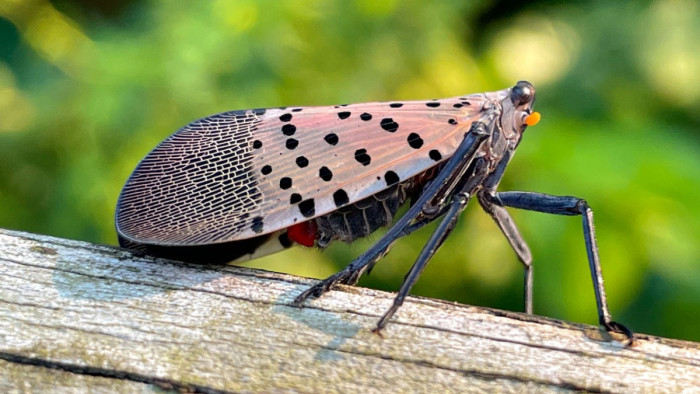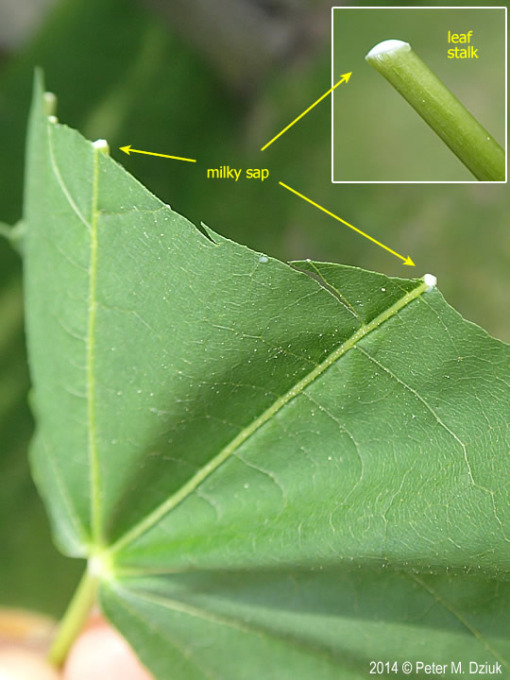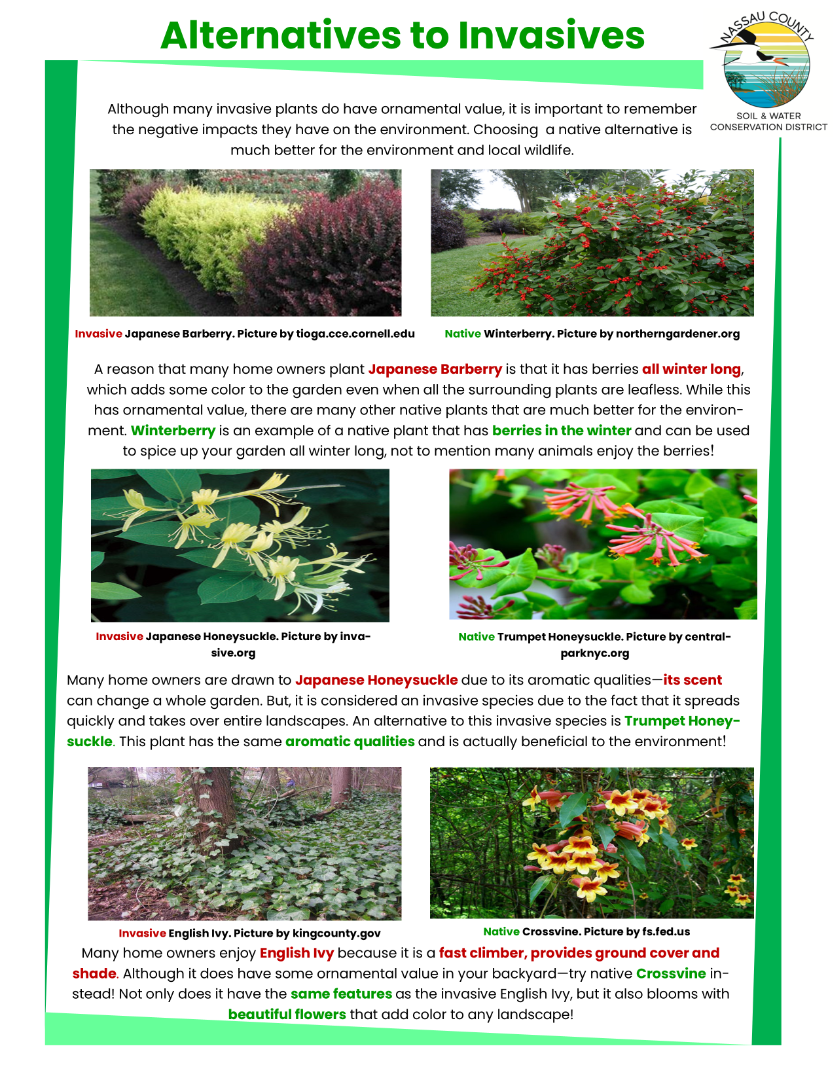Invasive Species
What is an invasive species?
Invasive Species are any organisms that are not native to an ecosystem and cause harm to its environment. Invasive plants and animals typically outcompete native species for resources like food and sunlight by spreading aggressively, reproducing quickly, and altering the natural environment. Long Island is home to many types of plants and animals, all competing for food and space to grow. Different species are classified into types depending on their impact on the environment.
Native Species are species that, once established, thrive in the environment they are naturally adapted to.
Invasive Species are capable of rapid spread into relatively undisturbed natural communities. Once established, invasive plants begin outcompeting native plants, damaging soil, and causing adverse ecological impacts.

Porcelain Berry Ampelopsis glandulosa, also known as "pepper vine" and "wild grape". With the potential to overtake forested areas, an extremely inferior food source for our migrating birds, lacking the essential nutrient content and lipid fats compared to native plants.
Do you live in Nassau County and are interested in helping fight against invasives? Consider downloading the iMapInvasives app! This app allows you to take a picture of a plant or animal and identify that species instantly. You are directly helping scientists and environmental professionals by collecting data with iMapInvasives. The data you collect is then used to plan projects and manage invasive species throughout New York State.

How can you help?
Educating others
Learn more and educate others about the dangers of Invasive Species. Public awareness and education about invasive species are critical to preserving the health of our local plant and animal communities.
Collecting Data
Collect Data using tools like iMapInvasives, iNaturalist to identify local plants.
Volunteer
Volunteer with organizations like LIISMA, Save the Great South Bay, The Nature Conservancy, and NYS Parks to help eliminate the threat of invasive species in your local parks and preserves.
Seeking Volunteers & Interns

Interested in protecting your local resources? Looking for a chance to give back to your community?
The Nassau County Soil and Water Conservation District is currently seeking volunteers to help implement various environmental projects. No experience required. Weekend opportunities available.
Invasive Species Educational Databases
Know Your Enemy!
Learn more about different Invasive Species below
Southern Pine Beetle
This tiny but powerful insect has the potential to devastate many of Long Island's Pine trees. In New York, Pitch Pines (Long Island native) have been targeted more than any other species. Southern Pine Beetle has the potential to quickly spread throughout Long Island without proper management.

Spotted Lanternfly
This invasive tree hopping insect causes damage by sucking the sugars out of trees and plants, with the potential to destroy crops and damage forests the Spotted Lanternfly poses a signifigant threat to NYS and most of the United States

Invasive Plant Management Resources

Norway Maple (Acer platanoides) was introduced to America as an ornamental plant. Norway Maple is are prolific seed producer, and as individual seeds escape cultivation, the species now threatens forests and forest edges. Norway Maple releases a unique milky white sap when the leaf stalk is broken
Mugwort (Artemesia vulgaris) is an invasive perennial that is widespread throughout North America, though it is most common in the eastern United States and Canada. It commonly grows in nurseries, turfgrass, vineyards, waste areas, forest edges, and roadsides. Mugwort spreads aggressively through an extensive rhizome system and will readily form large, mono-specific stands. Mugwort is native to Europe and eastern Asia, where it has historically been used as a medicinal herb.

Mugwort in the early spring

Mugwort at the end of its growth cycle
Invasive Plant Facts
- Most invasive plant and animal species come from areas around the globe with similar climates to New York that are well-adapted and ready to spread quickly. This is why most invasives come from areas like Asia, Canada, and Europe. Invasive species come from different areas all over the globe.
- Birds and other wildlife carry seeds from invasive plants and spread them in their environment, even if you are not close to a forest. Keeping invasive plants can be harmful to your local environment. Many of the invasive plants that have taken over today's forests were first introduced as ornamental species to be used in home gardens and landscaping.
- Wildlife will eat the food provided by some invasive species after their native food sources have been used up, however, it does not provide the proper nutrition, causing some birds to not have enough energy to migrate.
Common Invasive Plants
-
Japanese barberry Berberis thunbergii
-
Mile-a-Minute Persicaria perfoliata
-
Multiflora Rose Rosa multiflora
-
Autumn Olive Elaeaganus umbellata Thunb
-
Canada Thistle Cirsium arvense
-
English Ivy Hedera spp.
-
Japanese Stiltgrass Microstegium vimineum
-
Garlic Mustard Alliaria petiolata
-
Japanese Honeysuckle Lonicera japonica Thunb.
-
Oriental Bittersweet Celastrus orbicultas Thunb.
-
Black Swallow-wort Cynanchum nigrum
-
Porcelain Berry Ampelopsis brevipedunculata

